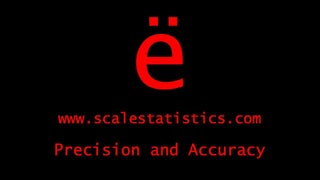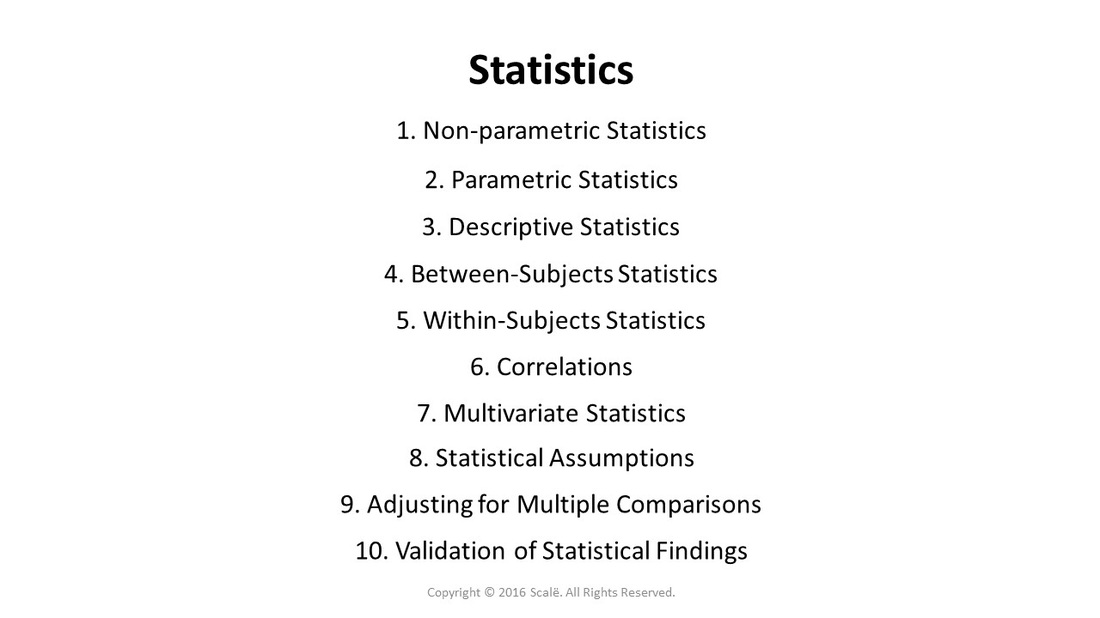Statistics
The Statistics decision tree will help in choosing the correct statistical test
Inferential statistics are used along with hypothesis testing to answer research questions. Researchers first make a null and alternative hypothesis regarding the nature of the effect (direction, magnitude, and variance). Then, they use statistics to either "reject" the null hypothesis (significant main effect) or "do not reject" the null hypothesis (non-significant main effect). All inferential statistics should be used in a hypothesis-driven fashion so as to not commit Type III errors (providing statistical results for the wrong question).
Before inferential statistics can be run on research data, certain statistical assumptions have to be met. It is EXTREMELY IMPORTANT to test for the appropriate statistical assumptions when conducting inferential statistics. If statistical assumptions are not tested for, then the inferences derived from statistical results are NOT VALID. The methods for conducting and interpreting the statistical assumptions of between-subjects, within-subjects, and multivariate statistics are presented in the Statistics engine of Research Engineer.
It is also important when running inferential statistics to check for post hoc significance, adjust for multiple comparisons, and check the robustness of predicted values of multivariate models. The methods for conducting and interpreting these statistical methods are also presented in the Statistics engine.
You will be asked a series of questions related to your research question and research design. Answer the questions to the best of your abilities. Your answers to the questions in the Statistics engine will lead you to the correct statistical test to answer your research question.
Statistical Package for the Social Sciences (SPSS)* is an incredible contribution to the field of empiricism as a whole, especially for appling statistics in the social and medical sciences. The user-friendly point-and-click interface coupled with syntax editing capabilities allows researchers to conduct a plethora of basic and complex statistical analyses. The steps for conducting and interpreting the analyses in SPSS Version 21* will be presented for each statistical test.
Before inferential statistics can be run on research data, certain statistical assumptions have to be met. It is EXTREMELY IMPORTANT to test for the appropriate statistical assumptions when conducting inferential statistics. If statistical assumptions are not tested for, then the inferences derived from statistical results are NOT VALID. The methods for conducting and interpreting the statistical assumptions of between-subjects, within-subjects, and multivariate statistics are presented in the Statistics engine of Research Engineer.
It is also important when running inferential statistics to check for post hoc significance, adjust for multiple comparisons, and check the robustness of predicted values of multivariate models. The methods for conducting and interpreting these statistical methods are also presented in the Statistics engine.
You will be asked a series of questions related to your research question and research design. Answer the questions to the best of your abilities. Your answers to the questions in the Statistics engine will lead you to the correct statistical test to answer your research question.
Statistical Package for the Social Sciences (SPSS)* is an incredible contribution to the field of empiricism as a whole, especially for appling statistics in the social and medical sciences. The user-friendly point-and-click interface coupled with syntax editing capabilities allows researchers to conduct a plethora of basic and complex statistical analyses. The steps for conducting and interpreting the analyses in SPSS Version 21* will be presented for each statistical test.
Types of statistics
What type of analysis will answer your research question? Click on a button below.
Non-parametric statistics are used when the outcome of interest is measured at a categorical or ordinal level. Non-parametric statistics are also used when the statistical assumptions of parametric statistics (normality, homogeneity of variance, etc.) are violated.
Parametric statistics are used when the outcome of interest is measured at a continuous level. Parametric statistics can only be used when the statistical assumptions of normality, homogeneity of variance (homoscedasticity), linearity, and model fit (residual analysis) are met.
Descriptive statistics are used when analyzing the distribution, dispersal, or frequency of predictor, confounding, or outcome variables.
Between-subjects statistics are focused on comparing independent groups or levels of a categorical variable on an outcome.
Within-subjects statistics are focused on assessing how an outcome changes across time or across within-subject observations.
Correlations generate statistical measures of strength and direction of association between two independent variables.
Multivariate statistics are conduct to understand the associations between predictor and outcome variables when controlling for various demographic, clinical, confounding, and prognostic variables.
Statistician For Hire
DO YOU NEED TO HIRE A STATISTICIAN?
Eric Heidel, Ph.D. will provide statistical consulting for your research study at $100/hour. Secure checkout is available with PayPal, Stripe, Venmo, and Zelle.
- Statistical Analysis
- Sample Size Calculations
- Diagnostic Testing and Epidemiological Calculations
- Psychometrics
More topics of interest within statistics
State the null and alternative hypotheses and set alpha and beta values for your research study.
Step-by-step methods for conducting and interpreting over 50 different statistical tests in SPSS.*
Learn more about various statistical assumptions and how to assess and interpret them in SPSS.*
Adjust for multiple comparisons and decrease experimentwise error rates (Type I error) using Bonferroni, Tukey's HSD, and Scheffe's test.
Validation of statistical findings using bootstrap, jack-knife, and split-group methods.
Hire A Statistician
DO YOU NEED TO HIRE A STATISTICIAN?
Eric Heidel, Ph.D., PStat will provide you with statistical consultation services for your research project at $100/hour. Secure checkout is available with Stripe, Venmo, Zelle, or PayPal.
- Statistical Analysis on any kind of project
- Dissertation and Thesis Projects
- DNP Capstone Projects
- Clinical Trials
- Analysis of Survey Data
*SPSS Version 26 (Armonk, NY: IBM Corp.).


